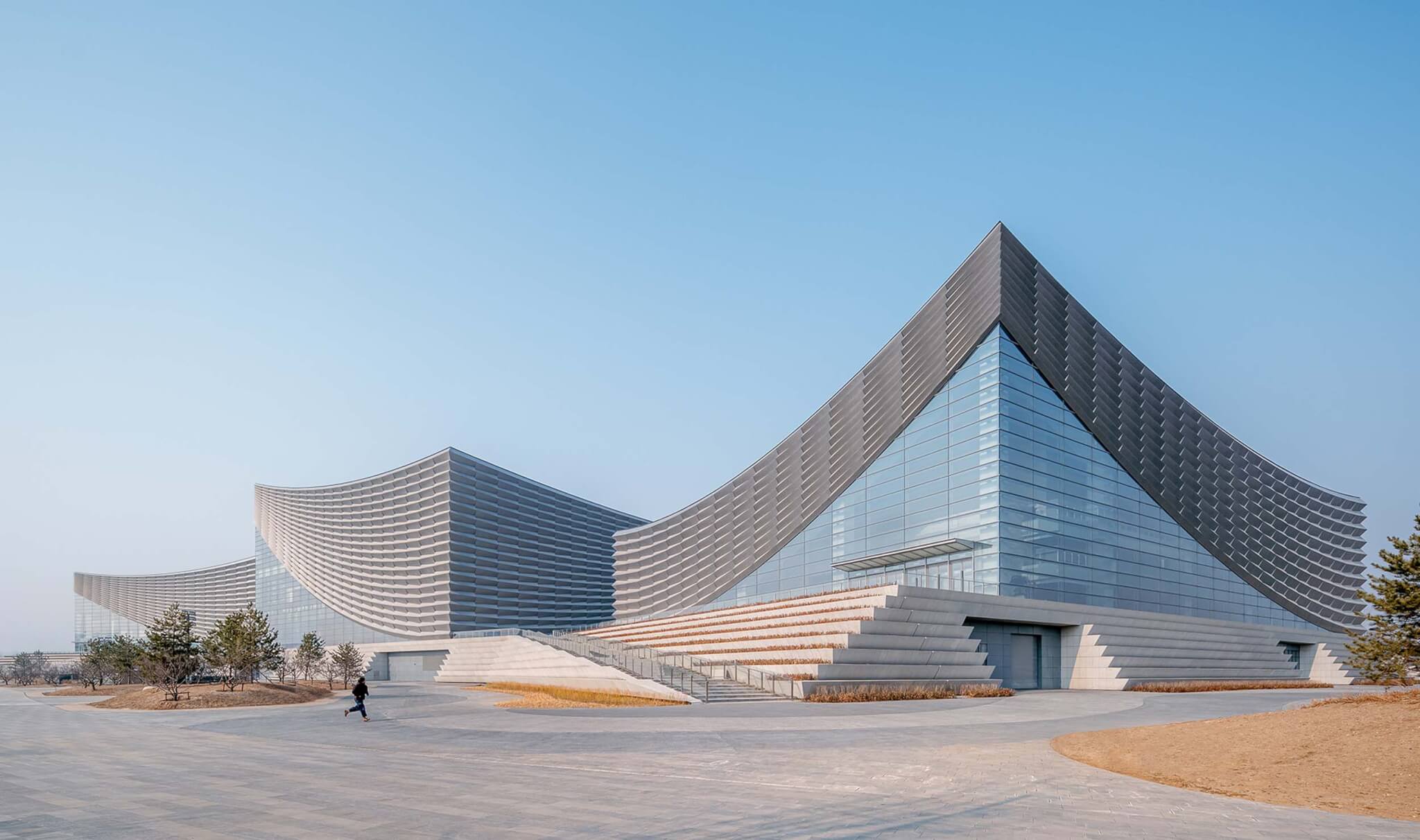- Design architect:
- Perkins&Will, Schmidt Hammer Lassen
- Location:
- Tongzhou, China
- Completion Date:
- 2024
On the banks of the Grand Canal in Tongzhou, China, the eastern gateway to Beijing, Perkins&Will and Schmidt Hammer Lassen (SHL) designed a performing arts center comprised of three venues. While the three structures differ in scale from one another, they share a visual and material symmetry recognizable in their material application: Each of the three distinct volumes is expressed with a undulating, faceted profile, and the roofline forms recall the storehouses that once lined the banks of the waterway.
Perkins&Will and SHL’s combined Shanghai studio was selected for the Beijing Performing Arts Centre project following a 2017 international competition that solicited proposals from practices around the globe. Rather than delivering a singular landmark or skyline-defining design, akin to the Beijing’s National Center for Performing Arts, the architects set out to design a building that would encompasses the nature and water it abuts.
“From the beginning, one of our main aims was to avoid one large singular building placed along the canal,” Chris Hardie, principal and design director for Perkins&Will/SHL, told AN. “Instead, we wanted the building to feel smaller and integrated with the parkland.”
The Opera House, the largest of the three new venues, is located in the center of the site flanked by the Concert Hall and Playhouse Theatre. Each of the lobby spaces was outfitted differently: the Playhouse is lined with black stone and red, the Opera House features strips of copper, and the Concert Hall is clad with light-colored stone.
Echoing the Sydney Opera House, the firm opted to locate each of visually similar yet structurally distinct volumes on a pedestal that raises the entire complex above the ground plane.

“Our approach was to place three objects on a plinth. The plinth would then splay and mold into the surrounding landscape and create a raised platform to overview the park and canal,” Hardie described.
The plinth connects the three venues at the ground level where many of the backstage spaces were located.
To determine the massing of the three volumes Perkins&Will and SHL looked to the canal’s history, proposing structures that reintroduced the “sweeping rooflines and simple geometry” of the goods storehouses that lined the waterfront in its industrial heyday.
The site’s relationship to the canal was also a starting point for the facade design. The pattern created by the aluminum facades is an homage to the sails of canal boats, the rendition shares fitting similarities with pleated theater curtains.

Hardie said the architects originally envisioned using ceramic for the facade, but quickly found the material was too heavy and would require more structural support. They instead turned to aluminum. Not only is the metal lightweight, but it could also be fabricated locally. Across the campus, more than 4,300 aluminum panel components are on display.

Reflecting on the project’s sustainability metrics, Hardie noted that while aluminum has a higher embodied carbon than ceramic, the team’s use of thin sheets actually achieved a lower embodied carbon than what the ceramic would have delivered. In terms of embodied carbon for the overall project, Perkins&Will and SHL had targeted 500 kilograms of CO2e per square meter as the maximum. The completed building performed better than that goal totaling 390 kilogram of CO2e, and also surpassed local standards on thermal performance by a 20 percent margin.

For added strength on the lower portions of the facade system 5-millimeter aluminum sheets were installed, while for the areas of the facade more than six meters above the ground (approximately 19 feet) 4-millimeter sheets were used. Each of the aluminum modules has a triangular, tent-like shape, wherein the upper portion is solid and acts as a shading mechanism. The lower panel is perforated with 30- to 40-percent openness.
The unique shape of the facade system was refined in Rhino using Grasshopper. The architecture team shared the model and algorithm with the facade contractor as 2D drawings that were used to guide the digital fabrication process. On-site, the design team examined several mock-ups, paying close attention to the look of the perforation, as well as factors such as lighting and maintenance.

The pattern of the perforation is consistent across all facades. Several design and mechanical requirements compelled the need for the small holes: daylighting, air intake for equipment, and smoke extract in the case of fire.

